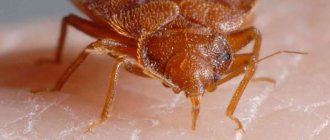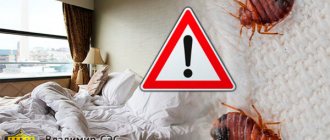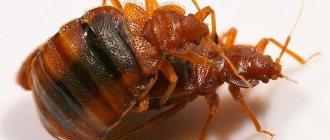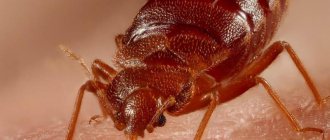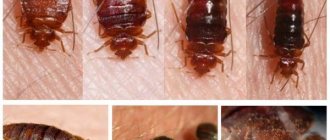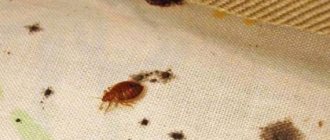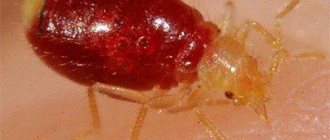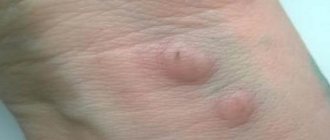Where do bedbugs live in an apartment and where do they hide?
To begin with, it’s worth listing all the places where bedbugs are found, because if you don’t have them yet, you can easily move them from there to yourself.
Hierarchy of the most common causes of bedbugs:
- hotel accommodation (even 4-5 stars)
- accommodation in dormitories
- accommodation in shelters
- accommodation in hospitals
- holidays in exotic countries (but not only)
- guests who have bed bug problems and stay overnight with you
- transportation of furniture (this happened during the transportation of new or used furniture, since new furniture and old furniture are transported during the same transport)
- used furniture
- moving from neighbors between apartments along the vertical building (this happens often, so we recommend sealing the apartment - cracks in the heating pipes that run vertically from floor to ceiling)
- transition from neighbors on the facade of the building (there are neighbors who have such numbers of them that live bedbugs are thrown out from under the bed from a dustpan directly into the toilet)
- public transport
- trains
- buses
- movie
- theater
- from work, if you work as a security guard, in a hotel, hospital, nursing home
- from the apartments of friends where you slept
- and other places where you sleep or stay in one place for a long time may have bed bugs
We look for bedbugs and find out if they are
Using a flashlight and a hard, flat-edged object, such as a credit card or paint scraper, inspect beds, mattresses and other areas where you suspect bed bugs. Look for bed bugs, eggs, feces or shed skins as evidence of an infestation. Be sure to look into cracks, crevices, and folds of fabric and furniture. You may also want to wear protective gloves during this inspection.
- Bed bugs are attracted to heat. The number one hiding place for bed bugs is in mattresses and beds. Inspect your sheets for blood stains that may have been left by bedbugs. Be sure to carefully inspect the seams and folds of the mattress in addition to any corners or crevices of your bed.
- Bed bugs also like to linger in areas where people sit or remain inactive for long periods of time. Sofas, armchairs, and even office chairs are popular hiding places for bed bugs. Be sure to look under furniture where the fabric meets furniture legs and between seat cushions.
- Bed bugs will also hide around the perimeter of the room. The edges of baseboards and carpets should also be checked.
And you must be prepared: if there are bedbugs, it will be difficult to get them out. You can get rid of them forever only when the premises are treated by specialists, and they will have to be poisoned several times.
IMPORTANT Bedbugs are able to survive in the most difficult conditions
Signs that there are bedbugs in the apartment
It is quite easy to understand that there are bedbugs in the house based on the following signs:
- bites on the human body (bugs do not bite animals, but can move on their fur);
- a specific smell (similar to sour raspberry jam or cognac of dubious quality);
- waste products in places where bedbugs accumulate: dead insects, dried feces the size of a poppy seed;
- small blood stains on the bed linen.
What does a bug bite mark look like?
Bedbugs constantly feed on blood. An adult insect bites several times in order to get enough, which is why marks called “tracks” appear on the skin. At the moment of the bite, the bug injects an anesthetic under the victim’s skin, so the person does not feel discomfort. But in the morning the wound turns red, swells and begins to itch. There can be many marks on the body, because absolutely the entire population feeds on blood, and each insect feeds once every 6-10 days.
In the center of the bite mark there is always a noticeable dot - a wound with a small bump in the middle. Traces of a bedbug attack cannot be confused with mosquito bites. In addition, they attack silently and all year round, and not just in the warm season.
If bedbugs bite even during the day, it means there are so many of them that the entire population simply does not have time to get enough during the night.
Does a bedbug carry infections?
It is believed that the bug does not infect the victim immediately at the moment of its bite; scientists have not been able to detect pathogens of dangerous diseases in its saliva. But they are present in the digestive tract and excrement, so the contamination of rice is still very high. Bedbugs can transmit tularemia, brucellosis, smallpox, hepatitis B, tuberculosis, typhoid fever and anthrax to you.
Stains on the bed
Small dark spots on the bed appear as a result of parasites damaging the sleeper’s skin and the release of a small amount of blood from the resulting wounds. In addition, when turning over in a dream, a person is able to crush a small insect, which easily bursts after a hearty meal.
Parasites often leave their feces on the bed. In this case, most often on the sheets, you can see brownish stains. They are especially visible on light-colored bedding.
Specific smell
Bedbugs can be detected in an apartment due to the appearance of a specific, sweetish odor. As a rule, it is present in a room with a high degree of infection. This “aroma” can easily be felt when entering a house from the street.
The smell, slightly reminiscent of cognac (it is also compared to the smell of fermented compote and stale raspberries), is present in the secretion secreted by females to secure eggs, or in moments of danger. Insect feces also emit a similar aroma.
Excrement and chitinous scales
Traces of the vital activity of parasites can be found in various corners of the apartment - on the floor, behind the bedside tables, on bed linen, on wallpaper. Liquid brownish excrement of bedbugs, solidifying, turns into solid small formations. Empty chitinous scales are formed during molting, when the insect sheds its durable shell and acquires a new one.
Signs of bedbugs
Clutches of eggs
Clutches of eggs will be eloquent evidence of the colonization of the premises by bloodsuckers. This unpleasant find is often found near sleeping places - beds or sofas. Bedbug eggs look like translucent grains of a slightly elongated shape.
Important! Having discovered signs of bedbugs living in an apartment, it is necessary to immediately begin the fight to free the territory. Delay in such a situation is extremely dangerous, as it leads to rapid proliferation of parasites and complete occupation of the home.
How do you know if there are bedbugs in your house?
The appearance of annoying bloodsuckers in an apartment, private house or country house is signaled by indirect symptoms and direct evidence. The main signs of contamination of a room include:
- the appearance of bites on the human body;
- unpleasant aroma in the house;
- obvious finds - waste products;
- traces of blood on the bed.
Bedbug bites. The first symptom of an ectoparasite invasion is the regular appearance of wounds. Bedbug bites are sometimes difficult to distinguish from attacks of other insects. However, there are a number of features that are characteristic exclusively of arthropod bloodsuckers.
How do bedbugs bite?
- Painless attack. During the bite, the adult injects an anesthetic substance into the body. The person feels discomfort the very next morning - the wound turns pink, swells, and itching begins.
- Multiple punctures. The entire population of ectoparasites, regardless of gender and age, are absolute bloodsuckers - they cannot exist without blood, and therefore without humans. The entire bug family takes turns hunting. The bug needs feeding every 6-10 days, nymphs feed more often.
- Footprints in the form of a path. An adult bloodsucker does not get enough of it with one bite; it takes several steps and pierces the skin again. The larva does not require much blood - the young nymph gets by with a single bite.
- The presence of a puncture in the center of the wound. Unlike allergies and the bites of some insects, the bug leaves marks with a small hole and a small bump in the center.
- Out-of-season bites. Mosquitoes attack people mainly in the summer, while bedbugs live near people all year round and adapt to different temperatures.
- New wounds appear in the morning. Bedbugs bite only at night, when the victim is sleeping and cannot harm the parasite. The next morning the person discovers new marks on the skin.
Important! If the bloodsuckers are no longer afraid and periodically bite, this is a clear sign that the colony is large. Ectoparasites do not have enough time at night to feed; they are forced to get out of their shelters and attack during the day.
Specific smell . Another sign of the presence of bloodsuckers is the appearance of a persistent foreign aroma in the apartment. The severity of the odor increases with population growth. Where bedbugs live long enough, people “sniff” and do not feel the unpleasant aroma.
Before determining the presence of arthropods, you need to leave for a couple of days - upon return, it seems as if it smells of sour raspberries or old cognac.
Some people manage to determine which places bedbugs have settled in by smell. Near nesting insects, the unpleasant aroma intensifies.
Waste products . The existence of parasites makes itself felt with unpleasant findings:
- translucent skins from larvae - during the growth period, the nymph sheds its chitinous cover 7 times;
- dried excrement - resembles small poppy seeds.
Such finds appear near the bed; bedbugs in books reveal themselves as dark dots on the pages.
Drops of blood . Once fed, the parasites slow down - they fill with blood, swell in volume and move slowly. In this state it is easiest to kill them. By tossing and turning in his sleep, a person can crush a bedbug and leave bloody marks on the bed.
An irrefutable proof of the presence of parasites will be an encounter with them. To avoid confusion, you need to compare the find with a photo of the bug. If inspection of the places where bloodsuckers usually hide does not produce results, you will have to conduct a series of experiments. You can use one of the popular ways to find where bedbugs are hiding:
- Get up in the middle of the night and suddenly turn on the light. Hordes of insects will be clearly visible on a light bed.
- If it’s a shame to dismantle the baseboards or tear off the wallpaper, you can crawl under them with a plastic card and take out the contents of the shelter.
These methods will also help those who are wondering how to find out that there are bloodsuckers in the sofa or are trying to find the habitat of ectoparasites.
How to check that bedbugs in an apartment live not only in the sofa
Even if it seems to you that bedbugs have settled only in the sofa and only in the living room, it would not hurt to conduct an experiment that will help you find out for sure whether this is so. Try sleeping on the floor or in another room, will the bite be just as bad? If yes, the answer is obvious - you should look for bedbugs not only in the sofa.
Accumulations of bedbugs in the house are never noticeable. Over the centuries of their existence, small bloodsuckers have learned to hide well - this is the key to their survival. Therefore, know that if you couldn’t find bedbugs in the sofa, then you either didn’t look well, or the resourceful insects chose another shelter in the house to live.
As our practice shows, most often the reason for the “invisibility” of bedbugs is an insufficiently thorough inspection of the sofa or bed. People take care of their property and conduct only a visual inspection in clearly visible places. And when the exterminator comes and unscrews the armrests, the backrest, and removes the upholstery, entire nests of bedbugs with nymphs (larvae) of different ages and eggs are discovered.
In addition, the settlement of indoor bedbugs is rarely local. Bed bugs multiply quickly in an apartment, and there simply isn’t enough room for them in the secluded corners of the sofa or bed. Therefore, they settle next to a person’s sleeping place and even at a considerable distance from him - as long as it is cozy and unnoticeable. It happens that bedbugs even come from neighbors at night, and, having had their fill, return to their secluded corner behind the wall. Most often, this happens when the apartment is poorly insulated from neighboring rooms, usually in dilapidated houses with cracked walls and loose baseboards.
How do bedbugs live?
For a bug, the main thing is that the food source is nearby. Therefore, most often they settle close to the place where a person sleeps. Nevertheless, pests run quite fast - more than a meter per minute. Therefore, even from the next room they can rush to the midnight feast.
Yes, bedbugs feed at night. And during the day they hide in the corners.
The body of a hungry insect is flat, like a coin. Thanks to this, bloodsuckers crawl into the narrowest cracks and holes. By the way, pests can feel completely safe only when their abdomen and back simultaneously touch two surfaces.
Parasites do not form full-fledged colonies, like other insects, but live in friendly crowds. Bed bug hostels are called nests. These nests contain everything: adult bedbugs, their larvae of different ages, eggs, shed chitinous shells, and excrement.
By the way, you can guess about an unpleasant addition to the house not only by obvious signs (bite marks on the body or blood stains on the sheets). Very often, pests are identified by discarded shells and excrement, similar to poppy seeds, which are lying here and there.
Lifespan of a bedbug
How long do you think bedbugs live? If you think it won't last long, you'll have to be disappointed. Although the lifespan of parasites is greatly influenced by temperature, they will haunt you for at least 8 months.
The most comfortable habitat for bedbugs is a room with a temperature of 25-30°. In such conditions, insects can live up to a year. At lower temperatures - up to one and a half years.
It should be noted that bedbugs take a maximum of 2 months to reach the larval stage (when parasites cannot reproduce). The rest of the time they multiply at an alarming rate. Therefore, if you do not destroy the nests of pests along with their inhabitants, insects will soon fill the entire house.
It's time to go in search of the parasites' concentration.
How to find places where bedbugs live in an apartment: rating of favorite hiding places
When searching for nests of bed bugs, you need to be guided by a simple rule - the more secluded and inaccessible the place, the more likely it is that bed bugs are found there. And on the contrary, searches in easily accessible places will most likely not be successful. So, if you are clearly determined to determine where bedbugs are sitting, aim to conduct a carefully thought-out search operation.
In beds and sofas, linen bugs mainly prefer to hide in the cracks between the boards, in the joints of frame elements, in the seams of the upholstery, but they can even be found in hardboard. Therefore, it is recommended to disassemble the sleeping places, sometimes even down to the last screw. You should be prepared for this, because when carrying out high-quality disinfestation, you need to treat each part separately. Professional exterminators almost always dismantle sleeping areas in search of bedbugs.
The video shows an example of how an exterminator identifies areas where bedbugs accumulate in an apartment:
To make it easier for you to determine in what places bedbugs live in an apartment other than sofas and beds, we list their types, ranking them according to the degree of reduction in the likelihood of infestation:
- The first and one of the most obvious places are cavities under baseboards and peeling wallpaper. This is where bedbug nests are most often located. They look like clusters of insects of different ages hiding next to clutches of eggs. If the renovation is not fresh, first of all you need to check for loose joints; bedbugs love to huddle under them. Most often, wallpaper and baseboards are infested near sleeping places, but with an increase in the number of bedbugs, the territory of their settlement expands to the entire apartment. Often, to destroy parasites, wallpaper has to be peeled off and baseboards completely unscrewed.
- In addition, thanks to their flattened body, bedbugs can easily squeeze under floorboards, parquet, or laminate, as soon as cracks appear somewhere. They often inhabit spaces under the raised edges of linoleum. If during the work we discover nests of bedbugs in the underground space, then we lift all the lagging parquet and laminate, and partially or completely remove the linoleum. Otherwise the problem cannot be solved. To clearly verify this, watch a video about the treatment of a two-room apartment in Balashikha, located in an old house thoroughly infested with bedbugs. There, the bugs settled under the parquet, behind the baseboards, behind the wallpaper, inside the sofas and the armrests on them.
- Another favorite place of residence for parasites is the internal components of household appliances. Computer system units, televisions, laptops, printers, stereo systems, especially those installed in bedrooms near beds and sofas, are ideal for bedbugs to nest. Firstly, we use such household appliances superficially and rarely look inside, which means that it is safe there. Secondly, there is enough free space for small insects such as bedbugs, and they can feel cozy and free here. Thirdly, if the equipment is located not far from the bed, traveling to the sleeping victim every few days will not be a burden, so such a habitat, from the point of view of the bug, can be considered quite successful.
- As for closets: bedbugs are not found here as often as in sofas, behind wallpaper and baseboards. Treating closets and clothes in them is more of a preventative measure to destroy all parasites, even those that accidentally got into the closet, and prevent them from escaping to untreated areas.
- The kitchen also often becomes one of the favorite places for bedbugs to live, especially if the apartment is small and this room is adjacent to the room in which people sleep. Kitchen counters, appliances, walls, floors and baseboards should always be thoroughly inspected and treated.
- The cracks under furniture, especially heavy furniture that is rarely lifted and moved - cabinets, chests of drawers, a refrigerator - are very often infested with bedbugs. People rarely come here, so for parasites (bugs, cockroaches, fleas, ticks...) this is a suitable environment where you can live without fear in fairly comfortable conditions.
There are cases when, in heavily infested apartments, bedbugs are found in all such places. For example, here:
It is important to understand that the destruction of bedbugs, like other synanthropic insects, is a rather difficult task. If you only expect to spray the tops of the sofa and forget about the bedbugs, most likely you will fail. Thorough disinfestation requires serious preparation: a detailed inspection of the room and all the main places where pests hide for the presence of nests, dismantling sofas, removing baseboards, and then thoroughly processing all these places.
But there is good news: bedbugs do not grow inside mattresses, pillows and blankets if there are no holes in them. Insects cannot crawl through the fabric, so there is no need to open the bedding.
How to get rid of bedbugs in an apartment?
It is very difficult to destroy domestic bloodsuckers. They are tenacious, resistant to temperature fluctuations and are able to develop immunity to insecticides. Many years of experience in bullying allowed us to develop a set of techniques. Some of the room treatment tactics have an effect, while others, on the contrary, can only do harm.
Pest baiting methods
- traditional methods;
- use of household insecticides;
- professional disinfection.
Traditional methods are based on temperature exposure and repelling arthropods with herbal odors, destruction with improvised means.
Heat Treatment Options
- Freezing . Bedbugs die at temperatures below -15°C. However, death does not occur instantly; prolonged exposure to cold must be ensured. Infected items are taken outside and left for a couple of days. “Cold” treatment will help remove bedbugs living in carpets, pillows and other objects. But it will not be possible to radically eradicate the population.
- Heating _ You can treat your apartment with hot air using a steam generator. The method is effective if you find bedbug nests and act on the parasites locally. A steam generator will help if bloodsuckers have just settled in the house and their number is small.
- Ironing and washing . Local heat treatment can remove bedbugs that live in human clothing, curtains, sheets, etc.
Important! When choosing a temperature method, you need to understand how long parasites live in certain conditions, how long they need to be frozen or heated. If you do not maintain the time interval, then part of the population will survive and continue to reproduce.
The aroma method is more of a prevention than a method of destruction. Understanding where ectoparasites come from, you can arrange herbs with a pronounced odor: lavender, tansy, wormwood. If neighbors have bedbugs, then bunches of plants are placed in the air ducts and along adjacent walls.
Synthetic insecticides give good results. However, to get the effect, it is important to understand exactly where bedbugs live and how to remove them with chemicals. Failure to comply with the dosage and inaccurate “hit” will only contribute to the development of addiction in insects and complicate further disinfestation.
Where do bedbugs hide in an apartment - the parasites’ favorite habitats?
Bedbugs can live in any of the rooms of the apartment:
- in the bedroom;
- living room;
- in the kitchen;
- in the bathroom and toilet;
- in the pantry;
- on the balcony or loggia.
Bedroom
The bedroom is the place of human habitation where you should look for bedbugs in the apartment first. This part of the house attracts bloodsuckers due to the presence of a person in it during sleep. When examining the room, special attention should be paid to:
- The bottom of mattresses and the underside of mattress covers.
- The internal contents of the pillows.
- Bed mechanisms.
- Folds of bed linen.
- Sections of walls located behind the wallpaper.
- The folds of clothes hanging in wardrobes.
Bugs in the living room and bedroom
Living room
The living room is the next option where bed bugs hide in the apartment. They can live in upholstered furniture (poufs, armchairs), under linoleum, parquet, under carpets and carpeting, in electrical outlet boxes, in old books and picture frames standing on shelves, in the inside of household appliances, in computer keyboards , laptops, in window frames, between walls and central heating radiators.
Bathroom, kitchen and storage room
Insects feel less comfortable in the bathroom, toilet, kitchen or closets. In these areas of the apartment, bedbugs appear much less frequently, and their detection in such places is associated with the consequences of improper treatment. Sometimes home owners carry out pest control on their own, but they only manage to drive away parasites from their sleeping areas. As a result, bedbugs do not leave the home, but move to other rooms.
The kitchen is often considered by professional exterminators as a place where bedbugs can live in an apartment. If parasites have settled in the catering unit, their nests can often be found in soft corners located near the dining table.
Bugs in the kitchen
The parasite can get into the bathroom if a pet is bathing when it returns from a walk with an uninvited “guest” in the form of a bug on its fur. Here, the source of infection is usually small, which allows you to remove the parasites within an acceptable period of time and avoid their spread throughout the house.
Bedbugs can hide in closets in apartments. Insects are attracted here by accumulations of waste paper, linoleum, and old wallpaper that was never used for its intended purpose.
Balcony, loggia
A balcony or loggia are also possible places where bedbugs sometimes hide in an apartment. Taking refuge from the effects of insecticides, they can easily master them in the warm season. First of all, this possibility exists when this part of the apartment is filled with various rubbish - old mattresses, pillows, winter clothes. In such heat-intensive products, parasites are able to find completely comfortable conditions for themselves. If the balcony or loggia is kept in order and clean, insects will have nowhere to settle, and they will be forced to look for more suitable living conditions.
Interesting to know. Despite the great “love” for people, parasites never live in their hair or on their body. Experts believe that this behavior of insects is associated with the instinct of self-preservation.
What are bed bugs and what do they look like?
Bed bugs are small blood-sucking parasitic insects that live where people or warm-blooded animals live. They feed only on blood, mainly human. If the owners are away from home for a long time, then bedbugs can get enough of the blood of pets, but this is a fairly rare case. Insects are not whimsical; the main thing they need for life is access to human blood and a comfortable temperature regime . The ideal temperature for them is 25–30 degrees, the same as for humans. They attack a person at night when he is sleeping. Activity begins at three o'clock in the morning and lasts until 8 am. If the bug is very hungry, it can attack during the day, but this is a very rare case.
The bug is a rather small insect that causes big problems for humans.
Bedbugs live on average one year, maximum - one and a half years (at low temperatures). In cases where they cannot provide themselves with food, they are able to fall into a state that allows them to survive without blood for a year.
You can recognize a bug by its characteristic flattened body, the length of which reaches from 3 to 8.5 millimeters; body color: from dirty yellow to dark brown. On the head there is a proboscis, with which the bug pierces the human skin and drinks blood.
An insect that is saturated with blood can double in size and become less active.
The maximum size of a bug is 8 and a half millimeters.
Parasites have three stages of development: egg, nymph or larva, and adult. Blood feeding is necessary on each of them.
An adult bedbug can easily be replaced on a light surface; finding a larva is much more difficult
Video: bed bugs
Where do bedbugs hide during the day, is there a nest?
Parasites like to form nests in dry, warm places.
Visual signs by which you can find them:
- an abundance of black dots,
- clutches of eggs,
- dry remains of skins,
- white larvae,
- insect corpses.
Black dots are the waste products of bedbugs. The faster the parasites multiply, the more of them there are. Special detergents may be required to remove these contaminants.
Where do bedbugs hide in furniture and how to look for them?
Insects settle inside foam upholstery and cracks.
Most often, parasites choose the following pieces of furniture:
- Table, chairs. Bedbugs settle in cracks and joints of furniture parts. The older the item, the more likely it is to contain insects. Most of all they love warm places, details made of natural materials (wood, fabric).
- Bedside table, shelves for linen. Bedbugs hide and lay eggs in chests of drawers located close to sleeping areas. Stacks of linen, clothes, and towels are ideal places for them.
- Wardrobes, wardrobes. Parasites settle in them when there is more than 1 nest inside the apartment.
Bed and linens
A place to sleep is a likely habitat for bloodsuckers. If the bed uses a bedding block, it is worth checking the bottom. Light does not penetrate there, it is quite warm there - ideal conditions for the formation of a colony.
Advice! Check the seams of the mattress and pillows; there is a high probability of finding parasites there.
Nests do not form inside pillows, blankets, duvet covers due to their strong openness. But in the morning there are remaining traces of blood or excrement on the surface.
Other furniture and things
The following places are least likely to form a colony:
- areas between the wallpaper and the wall,
- floor space,
- plinth,
- wall hangings, picture frames,
- sockets, switches,
- curtains, curtains.
Sometimes bedbugs are found in chairs. They settle in the upholstery, the cracks between the fabric and the body, the seat, and the back. It is also recommended to inspect the bottom of the chair.
Be sure to read:
Bedbug repellent 'Executioner': instructions for use, composition, active ingredient, how to use
Bedbug habitats?
Suspecting the appearance of uninvited inhabitants in the apartment, many try to identify the habitats of bedbugs. However, all efforts are in vain, because ectoparasites skillfully hide from people and come out of their shelters at night.
Where do house bugs live? Bloodsuckers settle closer to humans. They smell blood, body heat and move closer to beds or sofas - where the owner sleeps. All optimal conditions have been created in the bedroom or room for bedbugs: comfortable temperature, humidity and proximity to a food source.
Important! It is the bed that often turns out to be a breeding ground for bedbugs. It’s not for nothing that these bloodsuckers are called bed bugs.
A small population initially huddles in a room, but as it multiplies and grows, the colony occupies almost the entire room, hiding from people wearing clothes in closets, mattresses and other secluded corners. Bedbugs do not settle in the kitchen or bathroom - just like on the street, it is difficult to attack a person there.
Before you start the fight against bloodsuckers, you need to decide where the bedbugs are hiding in the apartment and find nesting sites. This is not easy to do - after all, during the day the parasites are not active and hide in hard-to-reach areas.
How to detect bedbugs at night?
Bedbugs go hunting at night, but it is better for people to hunt them during the day. Otherwise, the forces are unequal. Therefore, we recommend doing nothing at night, except perhaps smear yourself with perfume with a strong lavender scent, and launch an attack on uninvited guests in daylight.
Bright light
If you wake up at night sweating, thinking that you have been bitten by a bug, then turn on a bright light. You probably won't see the bug, but it's unlikely to bite you again if you sleep with the lights on.
Flashlight
You will need a flashlight more during the day than at night. It’s good for them to shine light into cracks to detect bedbugs. “Night vision” flashlights have also appeared on sale, which allow you to detect a bug in the dark and not scare it away. However, why do you need these experiments? You can detect traces of bedbugs by indirect signs, and then begin the day's all-out hunt.
Plate or bank card
Sometimes there are recommendations to use a bank card to check narrow cracks in order to scrape out bedbugs or their eggs. But this is too disrespectful of money and a bank card. It’s better to use it to buy a good bedbug killer.
The secret of successful disinfestation: how professionals look for bedbug nests
People often call our company and wonder if they can kill pests themselves if there is only one bug or bite and, in their opinion, there is no point in calling a professional exterminator. They ask you to recommend effective preparations to spray sleeping areas. We never refuse help. But we are trying to explain that where one bug bites, most likely there are traces of its fellows. It’s easy to check: an adult bug usually feeds once every 5-10 days and sucks up to 7 mg of blood. If bites appear more often, then he is not acting alone. And in general, bedbugs do not live alone in an apartment; if a bug appears, it means there is a nest nearby.
A nest of bedbugs behind loose wallpaper in an apartment
To detect all bedbug nests in a room, professional exterminators first turn over and sometimes completely dismantle all sofas, beds and chairs in the room: remove the armrests, unscrew the sides, and, if necessary, even remove the upholstery and filling. Carefully inspect other upholstered furniture in the house (chairs with soft seats, kitchen corners, sofas, poufs, etc.). Often bedbugs crawl under the upholstery in places where staples have fallen out or there are holes; these areas are checked with special diligence. Next, a detailed examination of the seams of the mattresses is carried out.
It is especially difficult to do this not in apartments with a normal number of beds, but, for example, in hostels, where each room can have 6-8 beds with the same number of mattresses:
Then the remaining rooms of the apartment are inspected. The cabinets are moved away from the walls, a thorough inspection of the wallpaper behind them is carried out, if necessary, the baseboard is dismantled, and the floor covering is removed. Bookcases are inspected in detail (bugs can live in the spines of old books), panels and paintings are studied. And only after the maximum number of bedbug habitats has been discovered, the home is treated with an insecticide. After the product has evaporated, the furniture can be assembled and used for its intended purpose.
In our practice, there were cases when the location of bedbugs could not be detected in an apartment at all, but the parasites continued to bite people. And this happened because the nimble bloodsuckers, who lead a nocturnal lifestyle, made forays from their neighbors every night, and during the day they returned to their hiding places, where they were not visible. There can be only two solutions in this situation:
- The first is to agree with your neighbors to jointly remove parasites and carry out disinfestation of the premises at the same time;
- The second is to isolate the apartment as much as possible, that is, make sure that pests have no chance of getting into it.
The second option is not the best, but sometimes the only possible one, especially if the neighbors are intractable. There have been situations when bedbugs in an apartment were completely destroyed during pest control, but literally a few weeks later they were taken back from the neighbors again, and the whole epic was repeated all over again. There were even cases where people had to move out of their apartment because it turned out to be cheaper than doing a complete renovation of it.
In any case, it is often impossible to find absolutely all bedbug nests in an apartment, since some of them may be located in electrical wiring grooves in the walls, behind boxes, that is, in places where it is generally impossible to get to. In all such situations, high-quality processing compensates for such limitations in opening nests. For example, when treating a room with cold fog, the drug can be blown into cracks and holes to a depth of several meters. And when treated with hot fog, the insecticide itself penetrates into bedbug hiding places that could not be opened and people did not even know were present in the room.
However, our practice shows that in order to remove bedbugs forever, you need to open the maximum number of their nests, and then treat the room as thoroughly as possible with both cold and hot fog. With this approach, we manage to completely remove bedbugs the first time in 83% of cases. Here's the little secret to fighting parasites...

